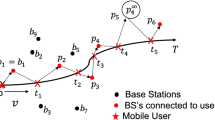Abstract
We study the signalling cost of different location management schemes under varying user behaviour in the case where one or several networks serve a certain region and where users may roam between these networks. For a user model, which has already been presented in [12], we propose a method for its parametrization. The focus of the studies and of the model is on the geographic distribution of origins and destinations of calls and location updates.
Similar content being viewed by others
References
G. Colombo, Mobility models for mobile system design and dimensioning, in: Proc. of the 9th ITC Specialists Seminar: Teletraffic Modelling and Measurement in Broadband and Mobile Communications, Leidschendam, The Netherlands (November 1995) pp. 133–146.
M. Hellebrandt, R. Mathar and M. Schopp, Optimum location management with Mirror HLRs, Research Report RWTH Aachen and Research Report University of Stuttgart – IND (1997).
J.S.M. Ho and I.F. Akyildiz, Local anchor scheme for reducing signaling costs in personal communications networks, IEEE/ACM Transactions on Networking 4 (1996) 709–725.
T. Imielinski and B.R. Badrinath, Mobile wireless computing: Challenges in data management, Communications of the ACM 37 (1994) 18–28.
R. Jain, Y.-B. Lin and S. Mohan, A forwarding strategy to reduce network impacts of PCS, in: Proc. of IEEE Infocom'95, Los Alamitos, CA, USA (April 1995) pp. 481–489.
R. Jain, Y.-B. Lin, Y.-B. and S. Mohan, A caching strategy to reduce network impacts of PCS, IEEE Journal on Selected Areas in Communications 12 (1994) 1434–1444.
M. Kwiatkowski, Calculating rates of services in UPT networks, in: Proc. of the 5th IEEE Internat. Conf. on Universal Personal Communications (ICUPC'96), Cambridge, MA, USA (September 1996) pp. 513–517.
K.K. Leung and Y. Levy, Data replication schemes for global networks, in: Proc. of the 15th Internat. Teletraffic Congress ITC 15, Washington, USA (June 1997) pp. 211–222.
K.K. Leung and Y. Levy, Global mobility management by replicated databases in personal communication networks, IEEE Journal on Selected Areas in Communications 15 (1997) 1582–1596.
R. Mathar and M. Hellebrandt, Optimum Mirror-HLR locations to reduce signalling load in cellular radio networks, in: Multiaccess, Mobility and Teletraffic, eds. D. Everitt and M. Rumsewicz (Kluwer, Boston, 1998) pp. 139–150.
A.D. Maylan, L.J. Ng, V.C.M. Leung and R.W. Donaldson, Network architecture and signaling for wireless personal communications, IEEE Journal on Selected Areas in Communications 11 (1993) 830–841.
M. Schopp, User modelling and performance evaluation of distributed location management for personal communications services, in: Proc. of the 15th Internat. Teletraffic Congress ITC 15, Washington, USA (June 1997) pp. 23–34.
J.Z. Wang, A fully distributed location registration strategy for universal personal communication systems, IEEE Journal on Selected Areas in Communications 11 (1993) 850–860.
Rights and permissions
About this article
Cite this article
Schopp, M. Location management in a multi‐network‐operator environment. Telecommunication Systems 15, 63–78 (2000). https://doi.org/10.1023/A:1019122324024
Issue Date:
DOI: https://doi.org/10.1023/A:1019122324024




